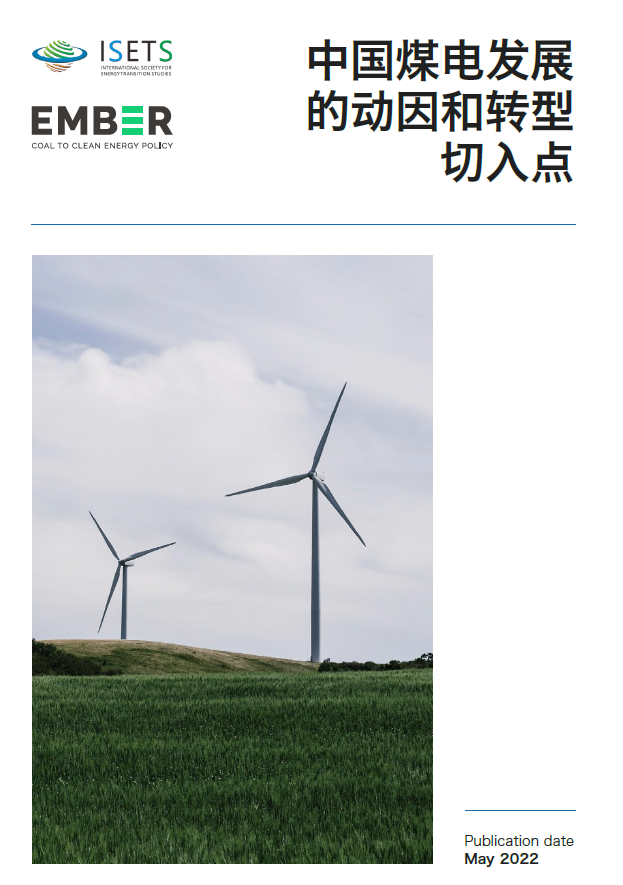
中国煤电发展的动因和转型切入点
作者
施训鹏,国际能源转型学会理事长
杨木易,Ember高级电力政策研究员
本报告对中国“十三五”(2016-2020年)期间煤电的发展及其背后驱动因素进行了梳理分析,并在此基础上对如何破除煤电的路径依赖,平稳有序推动煤电转型,助力“双碳”目标实现提出了具体政策切入点。报告旨在为中国今后的煤电转型形成一份“讨论文件”,期待报告能起到抛砖引玉的作用,激发能源专家和政策从业者就如何更好推动中国煤电转型展开深入辩论。
The main purpose of this report is to review the development of coal power in China during the 13th Five-Year Plan (FYP) period (2016-2020), focusing on its underlying drivers, as well as to identify possible policy entry points to shift the future trajectory of coal power development (i.e., mid-steps between goals and mixes of policy instruments for achieving the goals).
Key points from the report include:
•The expansion of coal power capacity in China continued during the 13th FYP period, though slower than initially planned.
•The coal expansion was reportedly to subserve four purposes: 1) alleviating local supply shortfalls; 2) improving the technical efficiency of coal fleet by replacing inefficient subcritical units with more efficient supercritical and ultra-supercritical ones; 3) providing heating services to both industrial and residential sectors, to reduce the use of more emissions-intensive dispersed coal(”散煤”)for that purpose; and 4) supporting the country’s West-East Electricity Transmission projects, aimed at transferring electricity from resource-rich western and southwestern provinces to the eastern coastal city-clusters, most notably Beijing-Tianjin-Hebei, Yangtze River Delta, and Pearl River Delta.
• The following factors have also made important contributions to the expansion of coal capacity: local governments’ fervour for coal power projects, the quota-based dispatching mechanisms for coal power, inefficiencies in the carbon market (for example, excessive and sometimes free allocation of emissions permits), negative externalities associated with overinvestment in coal power (i.e. lower revenues caused by overinvestment are distributed across all coal power plants), and inertia in the thinking of power system operators.
• China has recently signalled its intention to expedite electricity decarbonisation, where coal power will step down into a supportive role
in providing flexibility and backup capacity to the grids – essential for attaining higher levels of wind and solar penetration while ensuring supply security and reliability.
The report identifies four entry points for policy interventions to steer the transition of coal power to a supportive role:
Unlock coal power from its current development pathways: This requires limiting the impact of lock-in factors that have created a strong path-dependence for coal power development. Some of these factors are: local governments’ fervour for coal power projects; large sunk costs in the existing coal fleet that may become stranded if retired earlier than its technical life; and socio-economic concerns about coal power phase-out, especially in coal-dependent regions.
Market reforms: Transitioning from electricity generation towards the provision of flexibility and backup services to the grids would lead to fewer operating hours of coal capacity. Market reforms would be required to better incentivise coal power to provide these services. These reforms may involve strengthening the ancillary services market by: introducing new services required to manage challenges (for example, more frequent short-term supply-demand imbalances and a loss of inertia) imposed by rising renewable generation; and streamlining ancillary products (i.e. reducing the number of products associated with a specific ancillary service) to improve market liquidity. Capacity payments mechanisms may also be introduced
to better compensate coal capacity for providing backup services.
Better coordination between coal and electricity policies: Sufficient coal supply is essential for coal power to fulfil its supportive role in the electricity system. The power crisis in 2021 seems to have vindicated the viewpoint that to ensure this supply, better coordination between coal and electricity policies is needed. In 2021, the occurrence of extreme weather conditions significantly affected hydro and wind generation. Meanwhile, a very hot summer and strong industrial growth pushed up the demand for electricity. Coal power was called upon to fill the supply shortfalls, but its ability to meet this demand was affected by the coal supply shortages and associated high coal prices. The coal supply shortages were an outcome of measures to constrain coal production on various grounds, such as mine safety, environmental protection, and corruption. Despite being well-intentioned, these measures seem to have been implemented without due regard for their consequences for the electricity system.
A shift in governance towards a learning-based, reflexive process: The above-noted changes required for facilitating coal power transition engender a proliferation of complexity, cutting across diverse policy domains including energy security, economic development, and social wellbeing. How this complexity is perceived and the potential solutions that are offered could also vary from actor to actor, depending on individual viewpoints, perspectives, and interests. All these, effectively, make coal power transition a ‘wicked problem’ that is not expected to have one single, optimal solution. This means that the coal power transition cannot be effectively governed through conventional linear processes, in which policymakers first define the problem precisely and then identify and implement the most effective solutions to it. Rather, it requires a shift in transition governance from the existing linear process towards increased reliance on a learning-based, reflexive process. A key feature of this governance process is that it involves iterative ways of knowledge production and learning-while-implementing.
The report is available in Chinese at ISETS 2022 Coal power transition report

